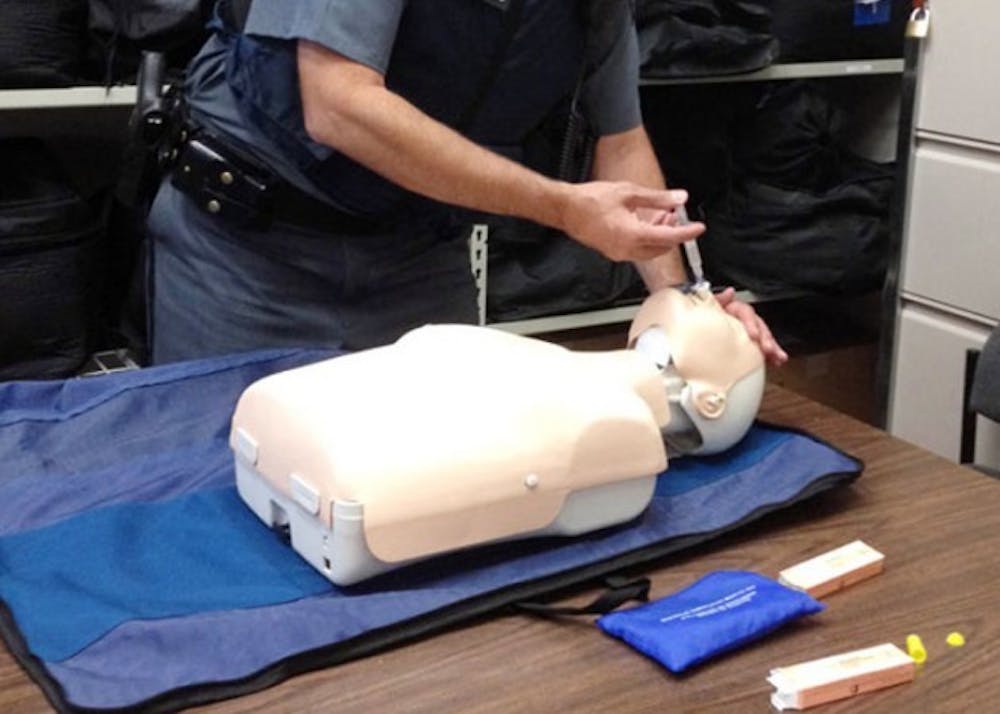![]()
Chief of the University Police Department Gerald Schoenle worries it’s “just a matter of time” before someone dies of heroin overdose on Buffalo’s campus.
Heroin-caused deaths have already happened at SUNY Oswego and Binghamton. But UB now has a method to combat the potential problem: antidote kits to provide pre-hospital care in case of heroin overdoses. Twelve SUNY campuses, UB included, received grant funding from the state’s Attorney General’s office for the naloxone kits, also known as narcan, to potentially save students’ lives.
“If we don’t do something like this, people are going to die,” said Lt. David Urbanek from UPD. “We are doing this to save somebody’s life if needed.”
In 2009, 12 people died from heroin overdoses in Erie County – that number has gone up to “at least 29” in 2013, according to a report issued by New York State Senate called “New York’s Heroin Addiction Crisis.” The Senate reports there’s an increase of heroin-related deaths across the state.
NYS Attorney General Eric Schneiderman launched the Community Overdoses Prevention program, which is facilitating the kits for the colleges. Buffalo received $3,600 for 60 kits, each kit costing $60.
Naloxone, the main component of the kit, is an effective antidote to reverse the results of heroin overdose.
A cheap high
Nearly half of young people who have injected heroin reported using prescription opiates before beginning heroin use, according to the National Institute on Drug Abuse.
Heroin is increasingly being used as a cheaper replacement to other opiates like oxycodone and hydrocodone.
Robert Granfield, a sociology professor at UB, said the trend of heroin replacing prescription drugs means that use of heroin is no longer confined to “poorer communities.”
“With the escalation of prescription drug use for non-medical purposes, there is a concern that heroin use on campuses will rise,” Granfield said. “The distribution of naloxone is related to [this] fact.”
Urbanek runs the kit-use training. He has served as an emergency medical technician for 36 years and has been an emergency medical service instructor since 1987.
Urbanek said the idea of heroin being available for “a couple of dollars” is dangerous.
Schoenle said no heroin overdoses have happened on campus recently, although there have been cases of overdoses for other drugs. There were 22 arrests for drug related violations in 2012 at UB, but none of them concerned heroin use, according to crime statistics on UPD’s website.
The Attorney General’s office has said two SUNY Oswego students have died from heroin overdoses since April, and two others suffered near-fatal overdoses, according to a CBS New York article. The same article reported a graduate student died from an overdose at Binghamton University last year.
Urbanek said UB is “being proactive” with its new antidote measures and the potential for overdoses on campus.
“We’re ahead of this,” Urbanek said. “It hasn’t happened yet, [but] we’re prepared for it to happen.”
A police force learns how to respond
Urbanek’s goal is to train every personnel including assistant deputy chiefs, lieutenants and detectives – not just officers – on how to properly administer the antidote. The training will take an hour and a half.
After narcan training, officers will be issued a prescription card from the Erie County Department of Health, authorizing them to carry the antidote drug.
The training includes hands-on practice of using benign narcan kits, learning symptoms of opioid overdose, effects of naloxone and reporting guidelines.
The antidote will be administered nasally. The drug works by displacing the opiates hitting the receptors in the brain. Patients typically recover within a minute. Each kit will contain two syringes, two atomizers for nasal administration, a facemask, sterile gloves and an instruction card.
An overdose of heroin can cause severe respiratory problems, leading to cardiac arrest and death.
There will be three officers at a time on North and South Campus with a naloxone kit. Urbanek also plans to have antidote kits in each police car; the cars are already equipped with Automated External Defibrillators.
Urbanek said naloxone does not cause any side effects and the naloxone will
block any opiate from being effective for 30 to 90 minutes.
When naloxone is administered, patients can go into immediate withdrawal.
Schoenle said students who overdosed will be covered under the Good Samaritan Law, which protects students from any charges and still enables them to receive basic medical help from UPD.
A version of this already exists on campus in the case of underage drinking.
UB Police views the naloxone kit as instrumental in ensuring student safety. UPD is uncertain of the precise number of heroin-related incidents on campus because once students are admitted to the hospital, their diagnosis – or, in these instances, the cause of overdose – does not need be shared with the police, according to Urbanek.
With the number of heroin-related deaths more than doubling in Erie County in the last five years, UB is ready should that trend extend to campus.
email: news@ubspectrum.com





